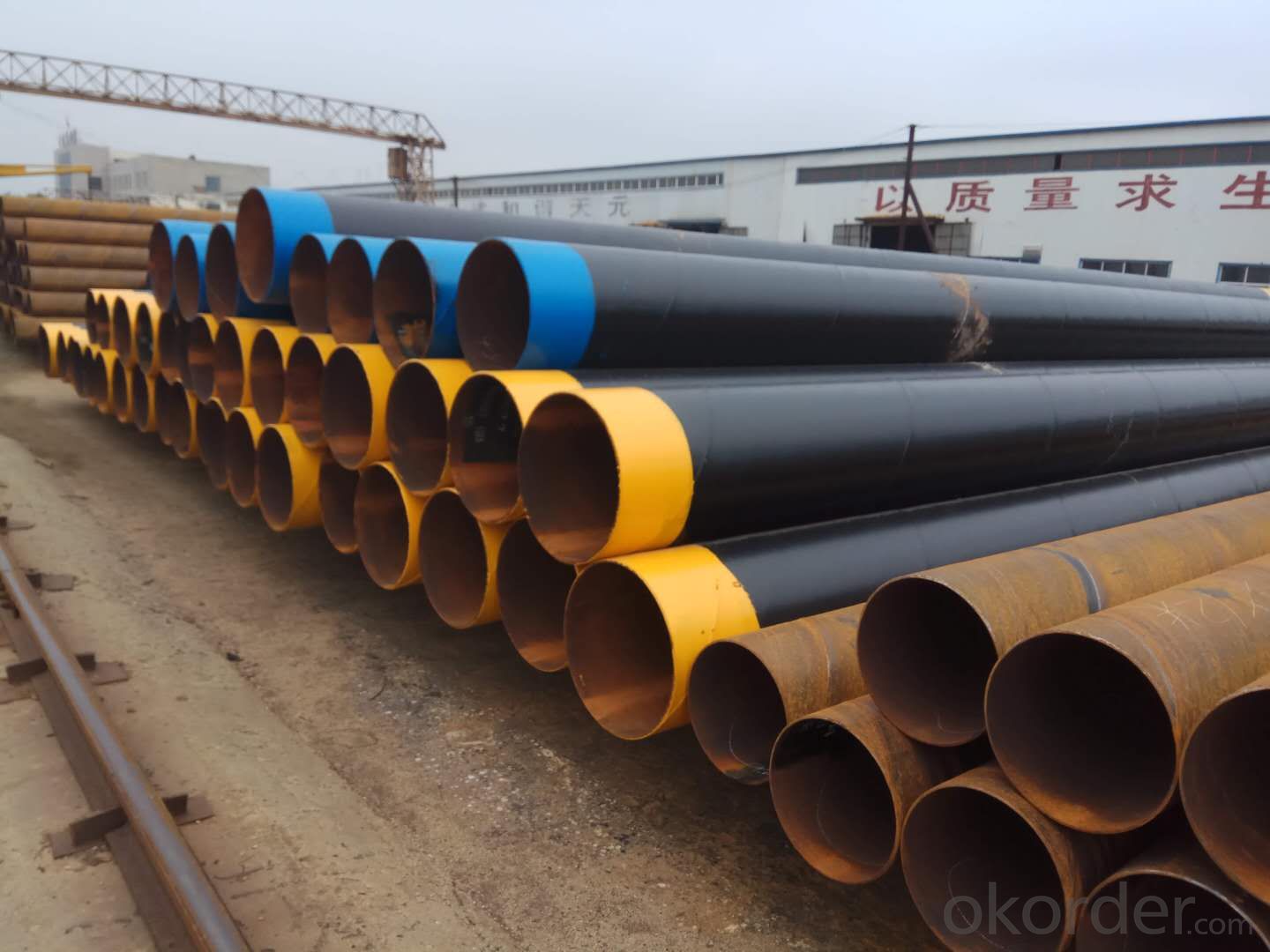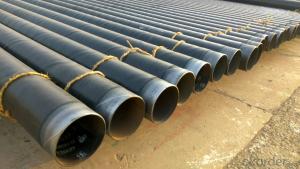Q235b spiral tube 3pe anti-corrosion steel tube
- Loading Port:
- Tianjin
- Payment Terms:
- TT OR LC
- Min Order Qty:
- 453 m²
- Supply Capability:
- 23222 m²/month
OKorder Service Pledge
OKorder Financial Service
You Might Also Like
Item specifice
In view of the excellent comprehensive tenderness of 3PE coating, it has been widely used in the world. For this reason, 3PE anticorrosive steel pipe has become the first choice for coating anticorrosion on these medium pipe projects. The quality control of the anti-corrosion coating of 3PE anti-corrosion steel tube, the process involved in the production of 3PE anti-corrosion coating is more complicated, and there are many factors affecting the product quality. Improper operation of each process can affect the quality of anti-corrosion steel tube. 1. Recommended service life: 3pe anti-corrosion spiral pipe can be used for about 30-50 years in basic cases, while epoxy coal tar anti-corrosion steel pipe has a service life of more than 20 years. Two, the processing technology is introduced: the main raw material of epoxy coal tar anti-corrosion for: coal tar epoxy primer and paint, epoxy coal asphalt cold wind belt of epoxy coal tar anti-corrosion is become people often say the two step, three oil five oil two step, a cloth two oil, epoxy coal tar anti-corrosion steel pipe construction, is applied to steel tube using coal tar epoxy paint, basic USES is painting forms. Click times: 174 update time [close] share: about 3pe anti-corrosion steel pipe manufacturer, base material a is PE jacket layer, base material c is epoxy coating. The adhesive used is a thermoplastic resin type thermoplastic adhesive made of polyethylene and modified by grafting maleic acid, which retains the structure, properties and processing characteristics of polyethylene and has good compatibility and adhesion effect with the jacket material. The production and r&d design of 33pe anti-corrosion spiral pipe is no longer a single paint brush. It should go through many projects such as rust removal, sand blasting, heating and spraying, etc. No less professional equipment should be carried out, and only the production is set up in 3pe anti-corrosion steel pipe manufacturer. Due to the particularity of anti-corrosion layer, professional production line of anti-corrosion steel pipe is needed. Tomorrow small make up special stick you solve you meet of difficult problem, 3pe anticorrosive helix tube price is appropriate very high, quality is not perfect, credit is not high and so on. 1. Production qualification: before purchase, it is necessary to see whether the qualification of 3pe anti-corrosion steel pipe manufacturer is complete, whether it has business license, and whether it has relevant r&d and design qualification. 2. Select material and specification: anti-corrosion steel pipe of what material is required, and consult whether this material is available, that is, whether the material is complete and whether the specification is complete.
The production and r&d design of 33pe anti-corrosion spiral pipe is no longer a single paint brush. It should go through many projects such as rust removal, sand blasting, heating and spraying, etc. No less professional equipment should be carried out, and only the production is set up in 3pe anti-corrosion steel pipe manufacturer. Due to the particularity of anti-corrosion layer, professional production line of anti-corrosion steel pipe is needed. Tomorrow small make up special stick you solve you meet of difficult problem, 3pe anticorrosive helix tube price is appropriate very high, quality is not perfect, credit is not high and so on. 1. Production qualification: before purchase, it is necessary to see whether the qualification of 3pe anti-corrosion steel pipe manufacturer is complete, whether it has business license, and whether it has relevant r&d and design qualification. 2. Select material and specification: anti-corrosion steel pipe of what material is required, and consult whether this material is available, that is, whether the material is complete and whether the specification is complete.
- Q:What are the different types of steel pipe supports for seismic applications?
- There are several types of steel pipe supports commonly used for seismic applications, including sway braces, rigid braces, snubbers, and restraints. Sway braces are designed to absorb lateral movement and provide flexibility during seismic events. Rigid braces, on the other hand, offer rigid support and resist movement. Snubbers are used to dampen pipe vibrations and prevent excessive movement. Restraints are used to anchor and limit the movement of the pipe during seismic activity.
- Q:Galvanized steel pipe in addition to good rust resistance, what are the advantages?
- Because the zinc has been plated outside the steel tube, the time for oiling or painting outside is omitted, and the construction is more convenient;
- Q:How do steel pipes handle expansion and contraction?
- Steel pipes handle expansion and contraction by allowing the material to expand and contract freely due to their inherent flexibility and elasticity. This prevents the pipes from experiencing excessive stress or damage, ensuring their durability and structural integrity.
- Q:How do you prevent steel pipes from freezing in cold climates?
- One way to prevent steel pipes from freezing in cold climates is by insulating them with materials such as foam insulation or heat tape. This helps to maintain the temperature of the pipes and prevents them from freezing. Additionally, ensuring that all cracks or openings in the walls or foundation where the pipes are located are sealed can also help in preventing the pipes from freezing.
- Q:How are steel pipes tested for quality assurance?
- Steel pipes are tested for quality assurance through various methods such as hydrostatic testing, non-destructive testing (NDT) techniques like ultrasonic testing, magnetic particle testing, and visual inspection. These tests ensure that the pipes meet the required standards and specifications, checking for flaws, defects, and proper dimensional accuracy.
- Q:What are the different types of valves used with steel pipes?
- There are several types of valves commonly used with steel pipes, including ball valves, gate valves, globe valves, check valves, and butterfly valves.
- Q:Can steel pipes be used for underground steam pipelines?
- Yes, steel pipes can be used for underground steam pipelines. Steel pipes are commonly used for various types of pipelines, including steam pipelines, due to their strong and durable nature. Steel pipes have the ability to withstand high temperatures and pressures, making them suitable for transporting steam underground. Additionally, steel pipes have excellent corrosion resistance properties, which is important for underground pipelines as they are exposed to moisture and potentially corrosive elements in the soil. Overall, steel pipes are a reliable and commonly used choice for underground steam pipelines.
- Q:A333gr6 steel pipe and domestic material of the same?
- A333Gr.6 steel is no nickel steel is a kind of fine grain aluminum low temperature toughness of steel, therefore, also called Al killed steel. A333Gr.6 belongs to the United States ANSI and ASTM-SA333 cryogenic steel standards and is used at the lowest impact temperature of -46 degrees celsius. Its temperature, range of use and fracture toughness value are similar to those of domestic 16Mn steel (the minimum usage temperature of 16Mn steel is -40 degrees Celsius).
- Q:What are the common uses of steel pipes in construction?
- Steel pipes are commonly used in construction for various purposes due to their durability and strength. One of the most common uses of steel pipes in construction is for plumbing systems. Steel pipes are often used to carry water, gas, and other fluids throughout a building. They are preferred over other materials due to their resistance to corrosion and ability to withstand high pressure. Another common use of steel pipes in construction is for structural support. Steel pipes are often used as columns or beams to provide structural integrity to buildings. They can support heavy loads and provide stability to structures, making them a popular choice in the construction industry. Steel pipes are also commonly used in the construction of bridges and highways. They are used for creating strong and durable bridge supports, guardrails, and signposts. Steel pipes are able to withstand extreme weather conditions and heavy traffic, making them a reliable choice for infrastructure projects. Furthermore, steel pipes are used for underground utilities such as sewer and drainage systems. They provide a strong and long-lasting solution for transporting wastewater and preventing leaks. Steel pipes are also used in the construction of underground tunnels and pipelines. In addition to these common uses, steel pipes are also utilized in construction for fencing, scaffolding, and handrails. They are chosen for their strength, versatility, and ability to withstand harsh environmental conditions. Overall, steel pipes are an essential component in construction due to their numerous advantages. Their durability, strength, and resistance to corrosion make them a reliable choice for various applications in the construction industry.
- Q:How do you calculate the pipe deflection for steel pipes?
- To determine the pipe deflection of steel pipes, various factors must be taken into account. Pipe deflection refers to the bending or displacement that occurs when a load is applied. The following steps outline the process for calculating pipe deflection: 1. Obtain the steel pipe properties: Familiarize yourself with the material properties of the steel pipe, including its Young's modulus (E) and moment of inertia (I). Young's modulus denotes the material's stiffness, while the moment of inertia measures its resistance to bending. 2. Identify the applied load: Determine the nature and magnitude of the load that will be exerted on the pipe. This may encompass internal pressure, external loads, or thermal expansion. 3. Utilize the appropriate formula: Depending on the load type and pipe support conditions, the suitable formula must be employed to calculate the deflection. For instance, if the pipe is simply supported (fixed at both ends), the formula δ = (5 * w * L^4) / (384 * E * I) can be used. Here, δ represents the deflection, w signifies the load per unit length, L denotes the pipe length, and E and I refer to the previously mentioned material properties. 4. Input values and compute: Insert the load, pipe length, and material properties into the formula. By doing so, the deflection of the steel pipe can be determined. It is crucial to note that calculating pipe deflection is a complex procedure that necessitates expertise in structural engineering. Therefore, it is advisable to consult a professional engineer or employ specialized software for accurate and reliable results.
1. Manufacturer Overview |
|
|---|---|
| Location | |
| Year Established | |
| Annual Output Value | |
| Main Markets | |
| Company Certifications | |
2. Manufacturer Certificates |
|
|---|---|
| a) Certification Name | |
| Range | |
| Reference | |
| Validity Period | |
3. Manufacturer Capability |
|
|---|---|
| a)Trade Capacity | |
| Nearest Port | |
| Export Percentage | |
| No.of Employees in Trade Department | |
| Language Spoken: | |
| b)Factory Information | |
| Factory Size: | |
| No. of Production Lines | |
| Contract Manufacturing | |
| Product Price Range | |
Send your message to us
Q235b spiral tube 3pe anti-corrosion steel tube
- Loading Port:
- Tianjin
- Payment Terms:
- TT OR LC
- Min Order Qty:
- 453 m²
- Supply Capability:
- 23222 m²/month
OKorder Service Pledge
OKorder Financial Service
Similar products
New products
Hot products
Related keywords
































